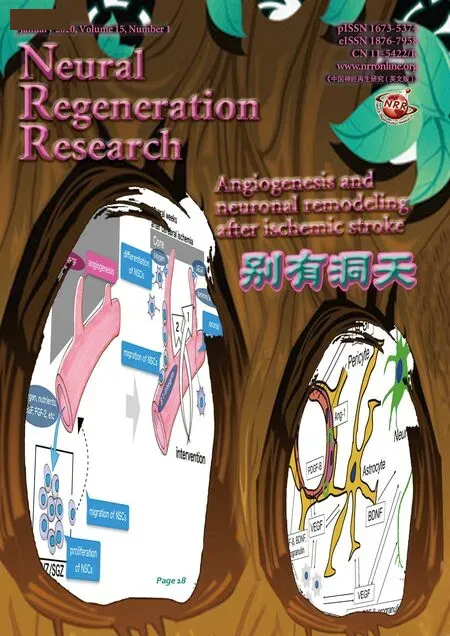LETTER FROM THE EDITORS-IN-CHIEF
Dear NRR Contributors and Reviewers,
Time flies! It has been 14 years since the founding of Neural Regeneration Research (NRR). With your continued support,the journal now becomes one of the finest journals in the field of neural regeneration research. Looking ahead to 2020,we thought it is a good time to share our thinking on new ideas and directions for the journal in the year to come.
Publish Novel Techniques in Neural Regeneration. In 2020, we will encourage publications to explore novel techniques to understand cellular and molecular mechanisms and develop novel repair strategies for neurological diseases.These techniques include, but are not limited to cell therapy,gene therapy, bioengineering, neuromodulation, medication,neuroprosthetics and advanced brain technologies (brainlike organ, brain-like computer chip, optical genetics, RNAseq, tissue clearing and light sheet fluorescent microscopy,single-unit recording, neuroimaging, big data management).
Initiate Special Issues on Neural Regeneration. The upcoming Special Issues in 2020 will include Advances of Neuromodulation in Neurological Diseases and Mental Disorders, and Retinal Neurodegenerative Diseases. Original research work, reviews, and editorials are welcomed to contribute to these special issues. We also will accept new proposals for Special Issues on other hot topics. As a Guest Editor, contributors will have an opportunity to edit a collection of articles in a particular topic related to neural regeneration. Preferences will be given to those who propose topics representing new advances in the field. International contributions from esteemed colleagues are particularly encouraged. The submitted work will be subjected to rigorous,transparent and fast peer review. Publishing special issues will increase the visibility of a specific research topic with the possibility of a freely shareable platform and networking with experts in the area.
Adopt CRediT during Submission Process.In 2020, in order to better enable discoverability and improve attribution,credit, and accountability, NRR will introduce the CRediT vocabulary of roles to provide transparency in describing authors’ contributions to scholarly published works (https://www.casrai.org/credit.html). CRediT includes 14 roles that represent the contributions typically made by authors of scholarly scientific journals and that measure individual impact more accurately. The NRR manuscript submission system, Editorial Manager, has recently integrated with CRediT.All authors will be requested to use CRediT roles to describe their contributions to original research and review articles submitted to NRR online. We sincerely hope the change will assist in the collection of relevant data during submission and peer review. Furthermore, the researchers, funding agencies, academic institutions, editors, and publishers can benefit from both the transparency and accessibility of research contributions.
International Neural Regeneration Symposium2020(INRS 2020). We would like to take this opportunity to share with you an exciting update about the 2020 International Neural Regeneration Symposium in conjunction with the 13thAsia Pacific Symposium on Neural Regeneration.The congress will take place in Nantong, China, between July 24 and 26, 2020. As this will be the 10thAnniversary of INRS,we look forward to seeing old friends and making new ones at INRS 2020 in Nantong!
Thank you again for your support! Let’s work together to strengthen the journal’s editorial perspective, and expand its readership. Our aspirations are to make NRR a leading journal in the field and to ensure that NRR clearly presents the unique academic characteristics of each article.
- 中國神經(jīng)再生研究(英文版)的其它文章
- Information for Authors - Neural Regeneration Research
- The multifaceted potential of the lipid transmitter oleoylethanolamide to treat alcohol-induced neuroinflammation and alcohol use disorders
- In vivo bioluminescence imaging to elucidate stem cell graft differentiation
- Modulation of lysophosphatidic acid(LPA) receptor activity: the key to successful neural regeneration?
- Combining fatty acid amide hydrolase(FAAH) inhibition with peroxisome proliferator-activated receptor (PPAR)activation: a new potential multi-target therapeutic strategy for the treatment of Alzheimer's disease
- 20S proteasome and glyoxalase 1 activities decrease in erythrocytes derived from Alzheimer's disease patients

